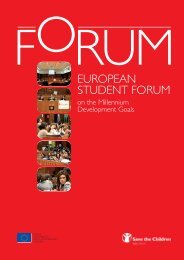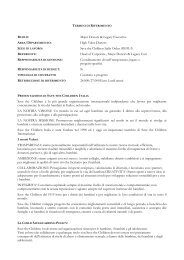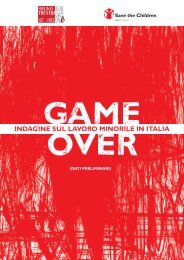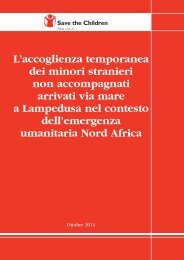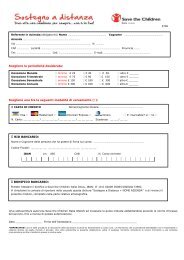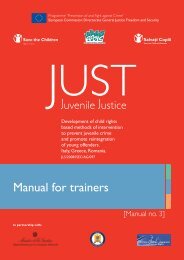FINAL REPORT - Save the Children Italia Onlus
FINAL REPORT - Save the Children Italia Onlus
FINAL REPORT - Save the Children Italia Onlus
You also want an ePaper? Increase the reach of your titles
YUMPU automatically turns print PDFs into web optimized ePapers that Google loves.
IPART27Stativă Ecaterina,IOMC, “BaselineSurvey on Rural ChildLabour in Five SelectedCounties”, Bucharest,2005.28Cace Sorin,ECHOSOCFoundation, “RomaWorking <strong>Children</strong> and<strong>the</strong>ir Families-SocioculturalCharacteristicsand LivingConditions”, RO MediaPublishing, Bucharest,2005.<strong>FINAL</strong> <strong>REPORT</strong>Development of a Child Rights Methodology to Identify and Support Child Victims of TraffickingTaking into account <strong>the</strong> environment where <strong>the</strong> children involved in labour exploitationcan be found, one can distinguish:• <strong>Children</strong> who work in <strong>the</strong> streetThe most frequent activities of children that work in <strong>the</strong> streets are: begging, loadingand unloading merchandise, washing windshields or cars in parking lots, sellingflowers or newspapers and collecting wastes.• <strong>Children</strong> who work in <strong>the</strong> rural areasThe daily tasks assigned by children’s parents in rural areas include cleaning up <strong>the</strong>house, cooking, feeding <strong>the</strong> animals, various agricultural works, taking care of youngersiblings, chopping wood etc. Some children work for a “local employer”. 27• Roma working childrenThe children work around <strong>the</strong> household or participate in agricultural activitiestoge<strong>the</strong>r with <strong>the</strong>ir parents, production or sale of different goods, collecting recyclablematerials, working in markets/warehouses, construction or in <strong>the</strong> street. Workinghours range between 4-10 hours a day and <strong>the</strong> children’s contribution to <strong>the</strong> family’sincome is usually already a tradition. 28One can also identify locations where trafficked children are very likely to be found.These are:• urban areas: streets; railway stations; central areas; subway stations;• rural areas: isolated villages; farms; mountain areas, where animal husbandry is practiced.Methods of recruitment, transport and trafficking routesIn <strong>the</strong> case of children trafficked for forced labour, including begging and illegalactivities, all <strong>the</strong> recruiters are Romanian nationals and are not necessarily part of anetwork that extends to <strong>the</strong> territory of <strong>the</strong> destination country. According to <strong>the</strong>research findings, <strong>the</strong>re are cases where victims were reportedly turned over to a networkin Romania or in <strong>the</strong> destination country.<strong>Children</strong> are mainly approached on <strong>the</strong> street, at railway and subway stations and incentral areas in urban settings. O<strong>the</strong>rwise, <strong>the</strong>y are approached in rural areas, in isolatedvillages and farms or in mountain areas, where animal husbandry is practiced.Most frequently, children are recruited by <strong>the</strong> family’s acquaintances or friends, with <strong>the</strong>consent of <strong>the</strong> family. It is very common that recruiters initially enter <strong>the</strong> family’s circleof friends with <strong>the</strong> specific purpose of recruiting children. Once <strong>the</strong>y get to know <strong>the</strong>family <strong>the</strong>y usually disclose <strong>the</strong>ir intentions and convince <strong>the</strong> parents or adultsresponsible for <strong>the</strong> children that working abroad gives better opportunities to <strong>the</strong> childand <strong>the</strong> family. In some cases one of <strong>the</strong> parents (usually <strong>the</strong> fa<strong>the</strong>r) accompanies <strong>the</strong>child to <strong>the</strong> country of destination. If this happens, it is very likely that <strong>the</strong> adultpreviously travelled abroad and is familiar with <strong>the</strong> itinerary and border crossing. In thissituation, adults do not fully understand that <strong>the</strong> child will be exploited and ra<strong>the</strong>rconsider <strong>the</strong>y will find legal employment. In o<strong>the</strong>r circumstances, parents sell <strong>the</strong>irchildren even though <strong>the</strong>y know about exploitative purpose, in which case <strong>the</strong> head of atrafficking network may send part of <strong>the</strong> child’s earnings to <strong>the</strong> family.Whatever <strong>the</strong> circumstances, recruiters usually offer <strong>the</strong> family mobile phones, clo<strong>the</strong>s, orjewellery already before <strong>the</strong> departure to influence <strong>the</strong>ir decision.Different is <strong>the</strong> situation where recruiters approach <strong>the</strong> victims <strong>the</strong>mselves. In this case<strong>the</strong>y offer <strong>the</strong> children good jobs abroad and children accept to go with <strong>the</strong> traffickerbecause <strong>the</strong>y hope to have a better life. In this case, traffickers do not offer any money orgoods before leaving. The dynamic is <strong>the</strong> same as <strong>the</strong> one described for childrentrafficked for sexual exploitation.Ano<strong>the</strong>r case is that of teenagers who decide to leave on <strong>the</strong>ir own under <strong>the</strong> influence of<strong>the</strong> gangs <strong>the</strong>y are part of. They are introduced to adults who facilitate <strong>the</strong>ir departure oreven accompany <strong>the</strong>m to <strong>the</strong> destination country (<strong>the</strong> preferred country in this casebeing Italy). In this situation, <strong>the</strong> teenagers become vulnerable to trafficking once <strong>the</strong>y<strong>FINAL</strong> <strong>REPORT</strong>Development of a Child Rights Methodology to Identify and Support Child Victims of Traffickingreach <strong>the</strong> destination country and are not victims when <strong>the</strong>y leave <strong>the</strong> country of origin.Ra<strong>the</strong>r than trafficking, <strong>the</strong> situation is that of smuggling.In <strong>the</strong> case of trafficking for exploitation in forced labour, both in <strong>the</strong> case ofinvolvement of <strong>the</strong> family or when children travel alone with <strong>the</strong>ir trafficker or recruiter,<strong>the</strong> most common means of transportation used to reach <strong>the</strong> destination countries arebuses of specialised travel agencies and trains. Parents or recruiters only use certaincompanies recommended by those who had successfully managed to get to <strong>the</strong>destination country. Drivers usually are well experienced and provide advice or tips about<strong>the</strong> possible obstacles or risks involved in crossing <strong>the</strong> border.In many cases, recruiters use several different transportation companies on <strong>the</strong>ir way to <strong>the</strong>destination country. They prefer to travel first to one of <strong>the</strong> capitals of a neighbouringcountry (e.g. Budapest, Belgrade, Sofia) and <strong>the</strong>n use a bus from a local transportationcompany. This is done to avoid strict inspections of tourist buses coming from Romania.As happens in <strong>the</strong> case of trafficking for sexual exploitation, illegal crossing of <strong>the</strong>Romanian borders to neighbouring countries is usually done with <strong>the</strong> help of“specialised” guides. Thus, <strong>the</strong> guides, recruiters and transporters are some of <strong>the</strong> mostimportant intermediaries for traffickers in <strong>the</strong> destination country.Living conditions and forms of exploitationBefore leaving <strong>the</strong> country, trafficked children already used to work in <strong>the</strong> in street fora long time, sometimes more than eight hours per day and in very difficultconditions (unbearable heat or very low temperatures). Many children suffered skindiseases, tuberculosis, and hepatitis as a consequence of <strong>the</strong> unhygienic conditions <strong>the</strong>yare used to living in. Most of <strong>the</strong>m were also involved in illegal activities such as drugdealing. The number of school drop outs among trafficked children seems to be veryhigh. In some cases, although not as frequently as for child victims of trafficking forsexual exploitation, children were physically abused.As far as Roma children are concerned, <strong>the</strong>ir involvement in work in order to contributeto <strong>the</strong> family income is a tradition. <strong>Children</strong> work within <strong>the</strong> household (cleaning,taking care of younger siblings) and/or participate toge<strong>the</strong>r with <strong>the</strong>ir parents inagricultural activities, production or sale of different goods, collection of recyclablematerials, working in squares/warehouses, in construction or on <strong>the</strong> street (begging orwashing windscreens of cars). Working hours range between 4-10 hours a day. There arecases where children were exploited by <strong>the</strong>ir parents or relatives before being trafficked:<strong>the</strong>ir working conditions were intolerable and <strong>the</strong> risk of accidents, sickness or of beinginvolved in illegal activities, such as drug dealing, very high.Trafficked children generally work in <strong>the</strong> streets, which exposes <strong>the</strong>m to <strong>the</strong> risks of streetlife, and are mainly exploited in illegal activities, such as petty crimes, and begging but<strong>the</strong>re are also cases of children forced to work in agriculture, picking fruits or vegetables(Germany, Spain, Austria) and selling flowers. <strong>Children</strong> are also exploited through labourin constructions, (<strong>the</strong> Czech Republic).Trafficked children interviewed reported that <strong>the</strong>y faced harsh living conditions uponreaching <strong>the</strong> destination countries. Their housing conditions were appalling: verycrowded shelters with adults, tents, trailers, insalubrious or deserted houses andbasements. They were not given proper food and didn’t have enough rest time. Provisionor non-provision of food is a reward for <strong>the</strong>ir efficiency in collecting money or apunishment in <strong>the</strong> event <strong>the</strong>y are not successful. Violence is also commonly used tocombat children’s resistance or to increase <strong>the</strong>ir efficiency and dependency.<strong>Children</strong> told <strong>the</strong> researchers that <strong>the</strong>y were forced to earn a certain amount of moneyper day, o<strong>the</strong>rwise <strong>the</strong>ir traffickers used physical violence as a means of persuasion andintimidation. Even <strong>the</strong> children exploited by <strong>the</strong>ir parents or relatives admitted that <strong>the</strong>ywere afraid of <strong>the</strong> beatings at <strong>the</strong> end of <strong>the</strong> day. The money <strong>the</strong>y earned was given to <strong>the</strong>traffickers, but some children did not even know <strong>the</strong> value of money, ei<strong>the</strong>r because of<strong>the</strong>ir younger age or <strong>the</strong>ir poor level of education.They also said that being controlled by <strong>the</strong> traffickers, <strong>the</strong>y could not play or makefriends, nor could <strong>the</strong>y ask for <strong>the</strong> support of, and <strong>the</strong>reby benefit from, <strong>the</strong> socialservices provided in <strong>the</strong> destination countries.IPART3839



